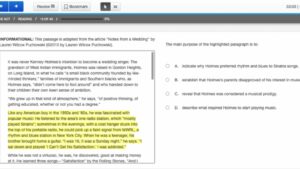Our Thoughts About the Online ACT

When we recently took the ACT online, we found advantages and disadvantages for test takers.
This blog post explains three strengths of the online format.
While the ACT’s online format has been around for a few years, it was given only on special test dates coordinated with schools, districts, or state departments of education. That means the only students who have experience with online testing (or will be required to use it in the future) are high schoolers in a school, district, or state that has moved to online testing.
For example, all public school students in Tennessee moved to required online ACT testing beginning with this year’s state-mandated test for seniors in October. The state’s public school juniors will be required to test online in Spring 2024. That same move happened in Kentucky last year. In both states, schools had the option to pilot online testing even earlier, meaning the ACT has been slowly rolling out online testing for a few years now.
So far, the national test dates have continued to offer only the paper version of the test, but that is about to change. The ACT recently announced a pilot program that will offer online testing to some students beginning with the December 2023 test.
That’s a first for the Saturday national test dates but likely indicates a trend to more fully embrace online testing. The SAT is now fully digital, and the ACT may move in that direction, too. For now, the ACT says students will have the option to take a paper test on the Saturday national test dates.
The current landscape is that students are taking both versions of the ACT and need test prep specific to the test format.
Three Advantages of the Online Format
1 // The Digital Timer
The timing of the ACT continues to plague test takers and is a top reason for stymied scores. Some students simply lose track of time and suffer the consequences–particularly on the math, reading, and science sections.
The online version of the ACT includes a digital countdown timer on the screen. Test takers no longer have to check their watches or constantly look at a clock on the wall. Instead, they can track the time and adjust their pacing without diverting attention away from the test.
The Jane Ross Tutoring student workshops now include tips that are designed for the unique elements of the online format. The video below explains our take on the advantage of the digital timer.
2 // Highlighted Text in the Reading Passages
The ACT reading section has always included questions with line references. With the paper version of the test, students had to locate the exact lines in the passage to answer these questions correctly. If students looked at a sentence or two before or after the specified line, they would likely end up with a wrong answer.
The online version no longer includes line references; in fact, the lines of the passage aren’t numbered at all. Instead, the computer version highlights the relevant part of the passage necessary to answer the question. No more getting lost in the reading passage– the answer is found in the text highlighted in yellow.

3 // Easy Navigation Between Questions
The online format keeps track of questions that students answer, skip, and/or bookmark. On the math section, for example, students often skip around. We advise students to answer all of the easy questions first and revisit the harder questions later. This approach was managed on the paper test by marking difficult questions in the test booklet.
The online version has a similar feature: Students can bookmark questions they want to revisit. Also, the computer keeps up with any questions that were skipped. Instead of flipping pages back and forth to find those questions as the time winds down, online test takers can simply open the review tab, view all categories of questions, and navigate directly to a question with a single click. Easy test navigation is another advantage of online testing.